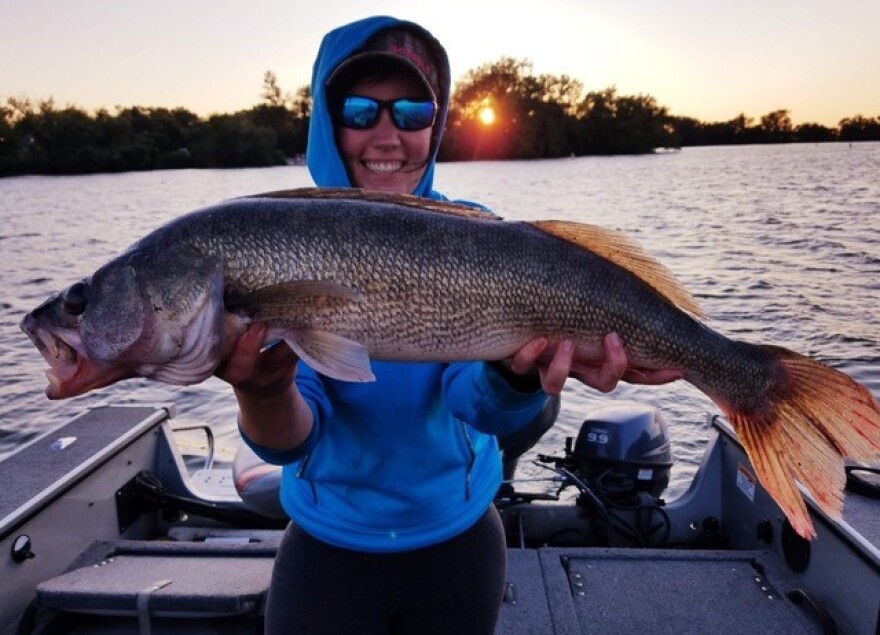It’s easy for me to get distracted, especially by things like hunting dogs.
So it wasn’t much of a surprise that my interview with the new executive director of the South Dakota Wildlife Federation went a bit sideways early on when I asked: “Do you have a dog?”
Turns out, Megan Howell has three dogs — a couple of Dachshunds and a Braque du Bourbonnais.
Wait, Braque du Bour what? Yeah, that’s kind of what I said.
Braque du Bourbonnais — pronounced “Brach-due-BOR-bun-AYE”
Or something like that.
“It’s like a French pointer, similar to a German shorthair,” Howell explained by phone a few days back. “I just lost a 10-year-old. The one I have now is 13 months old. Great temperament, about 40 or 50 pounds. So they’re small enough for the house but big enough to go through pretty good cover.
“About 17 years ago my dad got the first one. We’ve had five or six of them between the two of us since then.”
Turns out, the breed goes back hundreds of years to the Renaissance, which was a pretty good place for a nosy French pooch to plant its roots. But the Braque du Bourbonnais didn’t make it to the United States until the late1980s.
And even now there aren’t all that many around the states.
“I’m a bird-dog nut, so it’s fun to have a rarer breed,” Howell said.

It’s fun, too, for an old reporter to learn about a hunting dog he’s never heard of during an interview about something else. Well, kind of something else, which is Howell’s new job. She started work for the South Dakota Wildlife Federation last week, as the first woman executive director in the organization’s history.
I could say that it’s about time, but I’d rather have Terry Mayes say it for me.
“The installation of a young woman to a leadership position at the South Dakota Wildlife Federation is an exciting and meaningful change,” Mayes said. “The timing of Megan Howell’s joining the federation is both timely and fortuitous, as new challenges loom in the future for outdoor activities. Her experience and vitality will serve the South Dakota Wildlife Federation well going forward.”
Working to return Federation to former status
Mayes speaks from a position of authority on such things. A retired highway patrol captain from Rapid City, he is a South Dakota native and a life-long hunter and angler. He has been and is involved in state, regional and local wildlife groups, and currently sits on the South Dakota Wildlife Federation Board of Directors, serving as the organization’s 1st vice president. Like many of us older outdoor folks, Mayes has watched changes come to hunting and fishing in South Dakota. Hunting in particular has become more commercialized and access to private land without hefty fees has become harder to find.
“The nature of hunting and fishing has evolved dramatically in the last few decades, with commercial pay hunting and a large increase in the percentage of out-of-state hunters,” Mayes said. “The South Dakota Wildlife Federation, as well as other outdoor organizations, has to adjust to those changes.”
Mayes believes Howell is the perfect selection to help lead the federation through such adjustments. And she joins an organization that has a solid foundation as one of the state’s oldest conservation groups.
The federation took shape back to the 1940s when resident sportsmen banded together to promote the conservation of wildlife, the protection of public lands and the preservation of access for public hunting and fishing.
The SDWF has long favored restrictions on the number of non-resident waterfowl hunters, the protection of hunting rights along roads and right-of-way lines, the purchase of land from willing private owners by the state Game, Fish & Parks Department for public hunting and fishing access and wildlife management based on established scientific principles.
The federation has consistently opposed restrictions on conservation officers entering private land to enforce wildlife laws, allowing big-game tags to be transferred or sold, closing roads to public lands or waters and giving the state Legislature budget control over the state Wildlife Division.
All of these issues can be and have been controversial. And on issues affecting wildlife and public hunting and fishing, the SDWF can be and has been in the middle of many debates before the Legislature, the state Game, Fish & Parks Commission and local government boards and commissions.
It’s a lot to handle. Howell knows that. Yet, she says it was love at first sight when she noticed the job description.
“I thought, ‘Oh, my gosh, that’s me!’” she said. “It seemed like a really good way to continue my career and make a big difference.”
The federation board of directors agreed. And now Howell begins the substantial task of rebuilding a statewide outdoor organization that isn’t quite what it was a generation or two ago in terms of influence.
That’s not to say the federation and its local affiliates have lost their voice on issues involving hunting, fishing, wildlife management, outdoor recreation and natural-conservation. The federation is still heard. And it still has influence.
South Dakota roots and finding peace in the outdoors
But it doesn’t have quite the clout it had during the best of times. Part of that is because of the changing times, some different people and personalities and philosophies in government and, perhaps, an overall decline in the respect for long-established outdoor traditions.
Howell hopes to expand the federation’s membership and help restore some of that old clout. She also plans to work on improving relationships between the federation and landowners across the state, calling on her past work experience with landowners and cooperative land management.
Her South Dakota roots are likely to help, too.
Howell grew up in Pollock, hunting with her dad and friends and fishing with her mom and dad. They loved walleye fishing in particular. And who wouldn’t, up in that area of the Missouri River, some of the best walleye waters on earth?
“I developed a deep passion for the outdoors during those years,” she said. “It keeps me at peace.”
During her high school years, her family moved to Iowa, where after graduation she lost the regular connection with hunting and fishing for a few years. She got it back when she went to Iowa State University, graduating with a degree in natural resources and ecology management.
Howell went to work for the Iowa Department of Natural Resources in a wildlife research center that studied pheasants as well as some fisheries and invasive-species research. When the funding for her Iowa DNR position expired, she took a job doing much the same work with the Minnesota Department of Natural Resources, looking at pheasant brood-rearing habitat and nest success, with some waterfowl research added in.
From there she joined Pheasants Forever in southwest Minnesota and began private-lands work.
“I loved developing relationships with landowners,” Howell said. “It was another mix of natural resources and private landowners. I was active with public access and acquisitions, with walk-in programs and with work that enabled us to improve habitat and manage habitat on those properties.”
She also got involved in pollinator-plot research, which is far more complicated and important than the habits and populations of bees. Most of the world’s flowering plants depend on pollinators. And wildlife of all kinds depends on healthy plants and vibrant ecosystems sustained by pollinators.
Little things have big impacts across the outdoors. Howell learned that early on from her experience in hunting and fishing. She added to that knowledge with her post-secondary education and further developed her understanding of wild things and places through her professional work.
All of which set her up well to move from Pheasants Forever to the South Dakota Wildlife Federation.
“I’m really excited to be part of the federation,” she said. “It’s early, but I’ve formulated a bit of a direction. I’d like to continue enhancing our Camo Coalition, our political force, with the affiliates and with the public. It’s important to get more backing behind that. I feel like a lot of sportsmen love what they do but aren’t necessarily as active as we’d like them to be in protecting our natural resources and our access.”
Youth and diversity essential to future of federation
The appropriately named Camo Coalition is the political arm of the federation. It employs lobbyists during the legislative session and targets issues key to sportsmen and sportswomen. Howell will be part of that lobbying. She got a taste of legislative business during the last full week of the session. And she’ll have plenty more time in the state Capitol in coming years.
“I’ll be working to gather as many hunters and fishers

and outdoor enthusiasts as I can to be more active in the political world,” Howell said. “Because that’s where we make changes and need to be strong.”
She’ll also be traveling the state to meet with SDWF affiliates and to work on relationships with landowners and landowner groups.
“I think the most important thing to remember is that most of the time we want the same thing,” she said.
That same thing is sound wildlife management, high-quality hunting and fishing and reasonable access to the state’s natural resources, both on public and private land. Mutual respect, too, of course, even while working through disagreements.
Howell will be working to expand the outdoor constituency by recruiting more federation members, including more women.
“I definitely want to work on that. it’s really important,” she said. “And that includes the board of directors. There’s not a single woman on the board. I’m looking forward to changing that.”
Just as diversity is essential in ecosystems, it will be essential to the future of the federation, she said.
“A lot of conservation organizations are now run by that same group, kind of the 50-plus males,” Howell said. “And if we don’t change that we’re going to have a problem.”
Part of that change will come through youth and youth outreach programs for hunting and fishing and taking kids outdoors in other ways, too.
“I’d like to get into the schools and maybe do a pollinator program, where we find an acre or two of land where kids can build a pollinator garden from the ground up, spread seed, watch plants grow, identify pollinators, learning and getting hands on in the natural-resources world,” she said. “I’d like to find some grants for these and other programs and projects.”
So, clearly, she’ll have a busy work schedule, especially during the next six months to a year as she settles into a new job and its many new challenges. But she’ll take time to relax, too, and find peace where she has always found it — in the outdoors.
“I’m a bird hunter, an ice fisher, a walleye fisher in general, a morel hunter and just a going-out-and-being-on-the-prairie person,” she said. “I’m a nut for the outdoors.”
She’s pretty crazy about dogs, too, including that French pointer with a name I still can’t quite pronounce.


